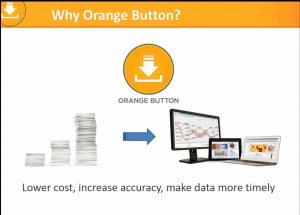Analogous to the impact of GAAP accounting protocols on financial reporting, the Orange ButtonSM Initiative is working to standardize and streamline solar data.
Orange ButtonSM is a Department of Energy SunShot funded program that started in 2016. Delivery partners affirm two critical areas of impact, finance and operations and maintenance (O&M) use cases.
Transporting data from application to application through a standardized data taxonomy to lower overall solar power system costs, increase reporting accuracy and ensure data delivery in a more timely manner are key deliverables for the initiative as voiced by Tom Tansy of the SunSpec Alliance, one of the program partners.
 To get an insider’s perspective on the coming impact of Orange ButtonSM on solar asset management software, Solar O&M Insider talked with participants in the recent InterSolar North America summit organized by SunSpec. Episode guests included Joe Cunningham, Director of Operations at the solar contractor, Sunny Energy LLC; Jon Previtali, VP Environmental Finance at Wells Fargo, a prominent tax equity investor in renewables and Laks Sampath, US and LATAM Country Manager at Alectris, an O&M services and asset management software provider.
To get an insider’s perspective on the coming impact of Orange ButtonSM on solar asset management software, Solar O&M Insider talked with participants in the recent InterSolar North America summit organized by SunSpec. Episode guests included Joe Cunningham, Director of Operations at the solar contractor, Sunny Energy LLC; Jon Previtali, VP Environmental Finance at Wells Fargo, a prominent tax equity investor in renewables and Laks Sampath, US and LATAM Country Manager at Alectris, an O&M services and asset management software provider.
For the full Solar O&M Insider discussion listen to the podcast or reference the transcript here.
The Need is Apparent for Solar Data Interoperability
“There’s no standard way right now for (solar industry) data to be exchanged,” said Aaron Smallwood, Senior Director Technical Services at the Smart Electric Power Alliance in a Greentech Media piece after the program launch. “That’s a problem for solar developers and the real estate and financial partners involved in bringing projects together and the owners and operators of the assets once they’re up and running,” he said.

Wells Fargo’s Jon Previtali: “The Orange Button initiative is something I am very hopeful will help streamline the data exchange for our solar portfolio.”
Jon Previtali of Wells Fargo illustrated the problem. The Wells Fargo portfolio includes 325 distributed generation and roughly 25 utility scale solar power projects. On average Previtali’s team receives input from 10 different platforms producing monthly operating reports from their asset operators. If an operations company is acquired or changes software, then one of those platforms can also change.
“The Orange Button initiative is something I am very hopeful will help streamline the data exchange for our solar portfolio. We have an incredible burden on us, on our portfolio management staff in the gathering of data from many different sources and formats including Excel, .pdf, Word, various portals, etc. We have a small staff of people who literally copy and paste it into Excel for use in quarterly and yearly reports. This is a very arduous process. It is an issue that is causing an inability for us to scale.
I’d like to get to a point using streamlined techniques like data interoperability and taxonomies like the Orange Button to eventually achieve a goal where this data comes to us automatically and is put right into our database. Then we can generate the reports automatically and our people can spend their time actually looking at them and analyzing the reports as opposed to creating them,” said Previtali.

Joe Cunningham of Sunny Energy LLC: “We’ve had to build our own custom platform to manage the business. That platform needs to integrate with others, and a lot of it is done manually.”
At Sunny Energy LLC, an EPC contractor installing residential and commercial solar, operations manager, Joe Cunningham said they have 1000 assets under management.
“We’ve had to build our own custom platform to manage the business. That platform needs to integrate one way or another, and a lot of it is done manually, with the other platforms that we work with whether they’re financial, or monitoring systems. Part of the problem there is mapping data fields. It’s easy to say an inverter is an inverter. But Orange Button is a whole lot more than just, ‘This is an inventor made by such and such manufacturer. Here is the model, etc.‘ All of the characteristics of the inverter that are important to the asset manager, the EPC, the owner, the warranty companies, providers and so on, also come along with the inverter identification. Having that taxonomy identified and defined so that everybody’s using it the same way eliminates our need to have to map everything together. Because it’s essentially already mapped, now we can start using the data from the systems if that’s done ahead of time,” said Cunningham.
From the third-party O&M provider perspective, Alectris manages 200+ large scale solar projects worldwide. Alectris uses its proprietary ACTIS solar ERP to aggregate and standardize data from multiple monitoring and equipment reporting.
“When you talk of multiple platforms, it’s not just multiple platforms alone, but you start diving into monitoring. There are multiple platforms. You dive into finance, there are multiple platforms. And you dive into CMMS, there are multiple platforms. Essentially, the challenge is to consolidate all these layers of multiple platforms into one dashboard,” said Sampath.

Laks Sampath of Alectris: “The biggest impact Orange Button will have for our ACTIS Solar ERP platform, which aggregates any type of data reporting into one dashboard, is we will know what kind of taxonomy we should follow in providing the data.”
“The biggest impact Orange Button will have for our ACTIS Solar ERP, which currently aggregates any type of data reporting into one dashboard, is we will know what kind of taxonomy we should follow in providing the data. Today, all of our reports are customizable, so if you have multiple power plants developed by multiple different EPCs with different monitoring systems, we still provide a uniform report. But that is based upon what the asset owner wants to see or the financing entity wants to see. With the taxonomy from Orange Button, it’ll help us streamline even further,” Sampath explained.
In a recent Orange Button progress report webinar, Tansy illustrated the problem with the graphic pictured below.
A pile of separate and disparate data sets, often in hard form, the industry is challenged to standardize into an accepted taxonomy and provided online via the Orange Button marketplace. API’s for software developers will help translate the taxonomy of thousands of accepted terms and definitions into exchangeable date accepted by international solar community.
All in all, an endeavor that promises to lower overall system soft costs, increase accuracy of data and make investment and management data more timely.
 Orange Button Information at Solar Power International 2017
Orange Button Information at Solar Power International 2017
At the upcoming Solar Power International, interested parties can get more information about the Orange Button Initiative at the program partner panel, Tuesday, September 12 at 9:30 am.
